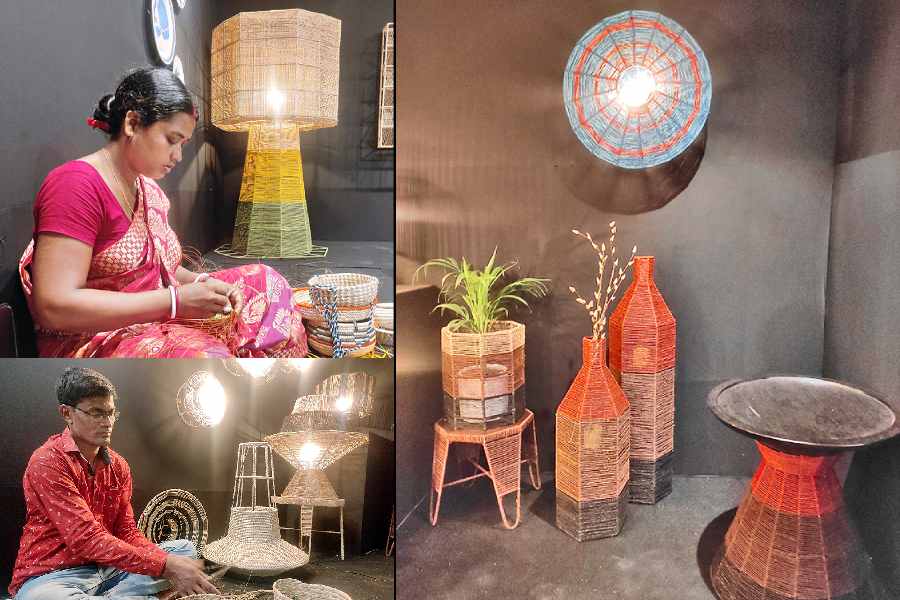Hiralal Mahata and Dipali Mura are weavers of sabai, a kind of grass that grows in abundance on fallow land in Jhargram and along the Purulia-Bandwan Road.
Sabai has been growing in these areas since time immemorial. Both Hiralal and Dipali have seen their grandparents and parents weave the grass into ropes and sell them in the local haat at Rs 20 a kilo. What they are doing is going several steps further. They grow, treat and then weave the wild grass to make lampshades, baskets, mats, wall decor and a variety of stuff that adorn urban spaces. They have been trained by the Rural Craft and Cultural Hubs (RCCH), a collaborative effort of the department of micro, small & medium enterprises and textiles, Government of West Bengal and Unesco. The RCCH was mandated to build capacity, provide direct market linkages, and exchange and collaborate with rural artisans.
Hiralal is from Raisole in Nayagram police station of Jhargram. He tells The Telegraph, “We used to make sabai ropes in between cultivating our fields. Now we are concentrating more on sabai work. And my whole family, including my wife and children, helps me when we have big orders.”
Sabai is easy to grow. And once it is sowed, it lives for a hundred years. The grass is cut around the Bengali months of Bhadra-Aswin (mid-September to mid-October), dried, coloured and then woven.
Dipali is from Mirgichami village of Purulia. She, too, weaves sabai into baskets, wall decor and a variety of items. She was trained by Paschimbanga Khadi. “They showed us how to design ourproducts, what colours to use. They gave us eco-friendly colours. NowI buy them from Burrabazar,”says Dipali.
There is a difference between the weaves of Jhargram and Purulia. While Hiralal braids the grasses to make ropes which are then fashioned into lifestyle products, Dipali sews the grass with its stems to make baskets and sundry other things.
“Dipali has recently been to Copenhagen (Denmark) to participate in the Women in Arts festival, where she sold her products and also interacted with fellow artisans from other countries,” said Ananya Bhattacharya of banglanatak.com, which is a design and implementation partnerat the RCCH.
Recently, the RCCH and Unesco held an exhibition, Daksha — Crafting Voices, curated by Swarup Dutta at Calcutta’s Birla Academy of Art and Culture sometime at June-end. Industry representatives, particularly from the hospitality sector and the field of interior design as well as corporates were invited to see first-hand the products by the rural artisans.
“The aim is to familiarise the industry with the quality of the handicraft emerging from our rural artisans,” says Amitabha Bhattacharya, also of banglanatak.
Dhokra, a textile from Dinajpur, made from jute and cotton on backstrap looms, is also gaining wide acceptance in the lifestyle products sector. Earlier dhokra items were made by weaving jute fibres only. That gave the items such as shoulder bags and mats a rough texture, abrasive to the skin. Amitabha says, “We got feedback that the items were too rough on the body. So we asked them to weave cotton into it to make them smoother.”
Rina Sarkar of Uttar Dinajpur weaves dhokra. “Earlier we would make dhokra bedspreads, mats for our own households. Then we were trained by banglanatak.com on design and use of colours and we started making these for sale at various fairs organised by them. Today, we take orders through WhatsApp and deliver. Biswa Bangla is one of our customers, as is Sasha and others,” says Sarkar.
Dutta, who is the lead designer and curator of Daksha, says: “I tried to develop a contemporary voice for our folk art practices so that the products can connect with the large urban market, specifically for the hospitality sector. “
The kantha corner at the exhibition, with its large black-and-white fish motifs on wall hangings and the elaborate needlework on huge lampshades, catch the eye. Tajkira Begum from Nanoor village shows off the lampshades. She has become a kantha ambassador of sorts as she traipses around the world showcasing her own work and that of fellow artists she trains. Trained by the Khadi and Village Industries Commission, Nabard, Rotary, District Industries Centre and District Rural Development Cell, she has a number of awardsto her name.
Asked how she gets her ideas for her designs, she says, “My designs are about my life in the village, men fishing at the pond, chicken laying eggs, frogs croaking.”
Talking about her overseas experiences, the 53-year-old says,“In an exhibition in Germany, Isaw that a small wooden box was priced at 12 euros while my kantha stole, a painstaking work done over a month, was priced at 15 euros only. I promptly changed all the price tags and raised the prices by several euros.”
The overseas exposure is actually more about building their confidence than selling their products, says Amitabha.
Snehashish Sarkar of Biswa Bangla, says, “We have much to learn from artists like Tajkira. Her kantha work is of a different standard altogether. She has not just helped herself but her whole village make a living out of this handicraft. Similarly, at Daksha I met a patachitra artist from Birbhum. He is very good, has inspired a lot of confidence.” He continues, “Sabai is now going to go mainstream, such is the quality of products shown at Daksha. It was a wonderfully crafted exhibition that will generate aof linkages for our artists fromthe hinterland.”










